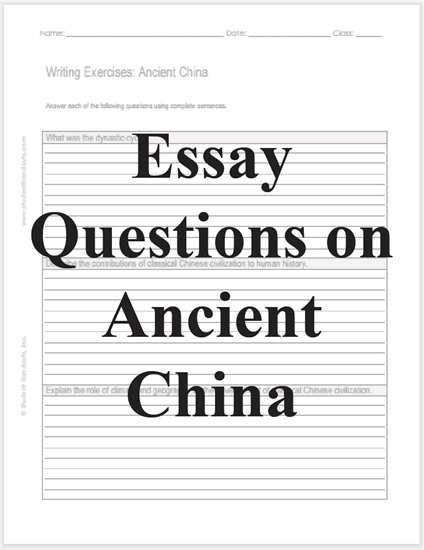| Essay Questions on Ancient China |
|---|
| www.studenthandouts.com ↣ World History ↣ Ancient East Asia ↣ Ancient East Asia Worksheets |
 |  |
|---|
|
1. What was the dynastic cycle? The dynastic cycle is a concept in Chinese history and political philosophy that describes the rise and fall of dynasties. It is a recurring pattern of how different Chinese dynasties would come to power, rule, and eventually decline and be replaced by a new ruling house. This cycle was a significant feature of China's political landscape for centuries. 2. Describe the contributions of classical Chinese civilization to human history. Classical Chinese civilization made significant contributions to human history in philosophy, governance, technology, and culture. Confucianism shaped moral and political thought across East Asia. The civil service system introduced merit-based bureaucracy. Innovations like paper, printing, the compass, and gunpowder transformed global communication and exploration. Chinese art, literature, and architecture influenced societies far beyond its borders, leaving a lasting global legacy. 3. Explain the role of climate and geography on the development of classical Chinese civilization. Climate and geography played a vital role in the development of classical Chinese civilization. Fertile river valleys, especially along the Yellow and Yangtze Rivers, supported agriculture and population growth. Natural barriers like mountains and deserts offered protection, while limiting outside contact. The varied climate allowed diverse crops and regional economies to develop, helping unify China under powerful dynasties and encouraging internal trade and cultural exchange. Click here to print this sheet of three essay questions. Answers will vary. |
| Ancient East Asia Books and Films | Ancient East Asia Outlines and PowerPoints |
| Ancient East Asia Maps and Pictures | Ancient East Asia Study Games |
| Ancient East Asia Miscellany | Ancient East Asia Worksheets |
www.studenthandouts.com ↣ World History ↣ Ancient East Asia ↣ Ancient East Asia Worksheets |










